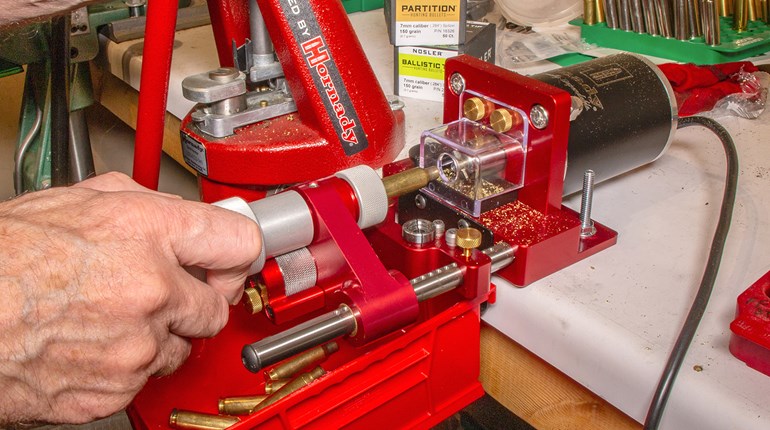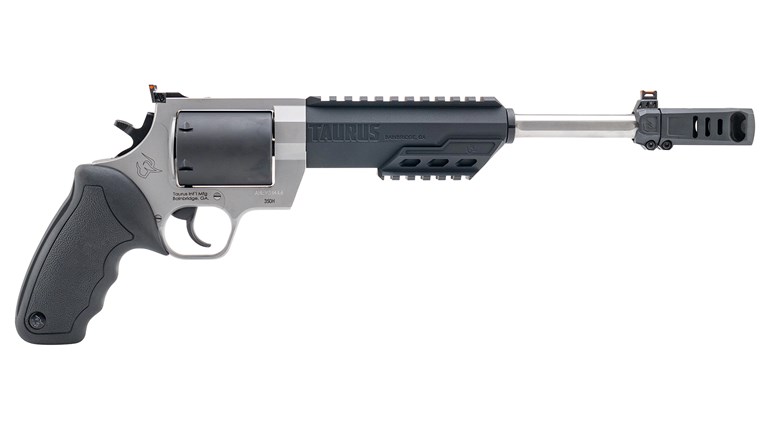
As indicated in this March 2020 article, we have some nice guns on hand from BUL Armory; here we focus on the SAS II for use in USPSA Standard or Limited divisions. Hand-built, the SAS II ($2,099 for the Standard .40 S&W model tested, gparms.com) is a full-length dust cover gun with a fiber-optic front sight and adjustable rear sight. The front cocking serrations match the look of the rear cocking serrations. Both sets of serrations look great and function very well. The thumb safety is ambidextrous and comfortable. Neither side of the safety dug into the hand while I fired the gun. The magazine release is large and protrudes enough to make hitting it easy. And, the slide release is textured for positive grip.

The Gun
The grip says BUL on the sides and the magazine well is labeled SAS II. The grip fit my hand perfectly, and allowed for a high grip on the gun. I was still able to deactivate the grip safety every single time I drew the gun on the clock. Every 2011 or 1911 I own has the grip safety pinned because I cannot consistently hold the gun where I want and deactivate the grip safety in a hurry. That was not an issue with this gun. The front and back strap of the grip are of a fine grain texture and the sides are of a larger grain texture that is aggressive without being extreme. The grip is more than suitable right out of the box and felt like it was custom-built for my hands. The trigger guard is slightly undercut and the trigger itself seems to be a little wider than normal, but it breaks crisply and resets nicely. I was able to do some preliminary shooting with the pistol, and the trigger was sweet. The website says the trigger weight is between two-and-a-half and three pounds, and that is easy to believe after having shot the gun.
Drills
With the SAS II in hand, I headed to the range. My plan was to do some additional range work with it and see how things went. I used a traditional Red Hill Tactical holster, hung on the same belt I wear every day and everywhere I go—no sexy competition gear here other than the gun. The holster fit it like a glove, with an added bonus—it allowed the firing grip to be achieved in the holster.

The first live-fire test was an unloaded table start with the magazine on the table and the hands relaxed at sides. Ten repetitions provided feedback about the texture of the cocking serrations, as well as the texture on the grip of the pistol. The very first rep was 1.87 seconds, scoring an A-zone hit with the target at five yards; the slowest was the third at 2.11 seconds. The remainder of repetitions ranged from 1.89 seconds to 1.60 seconds.
The next drill was a near to far array with targets at eight, 13, 16 and 28 yards. The near target was covered from the middle of the lower A zone down with hard cover, which would require some precision on the draw. The first repetition was the best run of the batch, 36 points in 3.96 seconds. The first five attempts at this array resulted in runs that were each under four seconds. Gun and holster both functioned well, but the shooter did have trouble with transitioning a little early on the second target a couple of times. Two additional runs with more front sight focus and less speed focus resulted in runs of 4.66 seconds and 4.83 seconds and each generated 38 out of the possible 40. This gun is very accurate.
For the next array, three targets at 23 yards were spaced five yards apart. The times for these runs were 4.02, 3.81, 4.27, 4.17 and 4.11 seconds. The points were good on all but one run. The gun came up to the eye easily and pointed very naturally. The comfortable, hand-hugging grip is a big part of this; the excellent balance of the gun is not hurting anything either. The draw times for these runs were 1.47, 1.49, 1.56, 1.62 and 1.48 seconds.

The next drill was to shoot a couple of strings of fire on a single target at 23 yards. I tried to shoot at an assessment speed, which is to say not group-shooting slow or at breakneck speed. The first string of six shots yielded five Alphas and one Charlie. The second string was four shots long and was three Alphas and one Charlie. The gun was balanced and smooth during this exercise, and the sight was extremely visible.
My analysis after having shot this gun twice is that it performs well with zero malfunctions. After shooting the gun indoors for the first time, the great trigger and accuracy of the gun was obvious. Shooting the gun outside the second time, drawing from the holster and doing USPSA-style shooting, the SAS II delivered every time.
Jake Martens and I took the gun to the range for some more shooting. We had four 17-round magazines from BUL to use for the session and one 20-round mag from MBX. However, STI and SV magazines are not compatible with the SAS II.
It was a windy day at the range, so we opted to use steel targets exclusively. Marten’s two runs ended with identical times of 5.69 seconds. There was a third and faster run, but the steel did not ring all 12 times. My two runs on El Prez were 5.70 and 5.58 seconds. The sights were easy to pick up and drive across the array; as mentioned previously the pistol is balanced and points naturally.

Next, we ran a little front sight forward drill. We used the same distance and spacing as El Presidente but were facing the targets and just shooting six shots total. Martens had four runs on this drill with times of 2.61, 2.51, 2.22, and 2.17 seconds. My three runs on this drill were 2.34, 2.23 and 2.27 seconds. The gun was drawn from the Red Hill holster.
The next drill was a near to far array of four targets requiring eight rounds to complete. The targets today were at 11, 16, 19 and 23 yards distance. The near target was off to the left and the far target off to the right at a width of 12 yards. This was a fair challenge for transitions to be sure. Martens stepped up and ripped off runs of 3.82, 3.61 and 3.65 seconds. My three attempts were 3.73, 3.77 and 3.50 seconds.
The Bill Drill came next. We were at the standard seven yard distance for this drill. Martens had times of 2.21, 2.04 and 2.14 seconds. My attempts at Bill Drills were weak to put it mildly. I did sprinkle a couple of decent reps into the mix of “doovers” and five-shot drills that I shot. The best times recorded on this drill for me were 2.13, 2.39 and 2.01 seconds. Being this was steel, we cannot say for sure how many of these hits were Alphas, but we can say for sure that they were not all Alphas.
To add movement to the testing of this gun, we added an eight-foot section of wall with a port in the middle to the near to far array. We started at the right-hand side of the wall, shot eight rounds on the four targets from that position, moving to the left-hand side to re-engage the same four targets. Thus, this 16-round exercise did not require a reload. Martens had two runs with all of the hits and with times of 8.75 and 9.62 seconds; My two reps were 9.31 and 8.50 seconds and were clean as well. We used all of the magazines on these runs and they all functioned well, as they did throughout the testing.
We used the same target array and wall section on the next drill. Beginning with hands on the port, we moved to the left to engage T1 and T2 around the left side. Next, we performed a mandatory reload and engaged T3 and T4 through the port, came into the second shooting position and engaged a 23-yard target. Marten’s three repetitions had times of 6.27, 6.05 and 5.94 seconds. His shooting on these three was pretty solid, although one of his reloads was sub-optimal. My three times on this were 5.95, 6.16 and 5.65 seconds.
Conclusion
We put between 900 and 1,000 rounds downrange with the SAS II. The gun performed well each and every time it was shot. The 17-round magazines would need extended base pads to compete in USPSA Limited division. Additioally, the single MBX magazine we had worked swimmingly, and would be an excellent option for Limited.
The SAS II would be a great Limited gun to have in your holster. Give it a try—you will not be disappointed. Follow BUL Armory on Instagram: @bul_armory.
Article from the May/June 2020 issue of USPSA’s FrontSight magazine. Photos by Isabel Martens.
See more: How To Avoid A Sweeping DQ


































